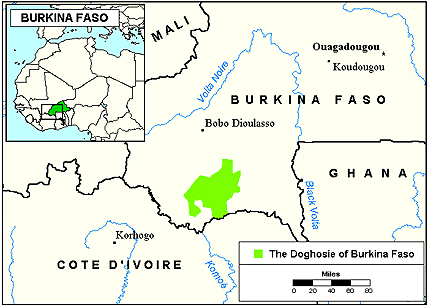|
|
Prayer Profile
The Doghosie of Burkina Faso
![[IMAGE]](../images2/0450.jpg) The Doghosie of Burkina Faso are culturally similar to the Lobi-Wala people, who also live in the Volta River basin region of Burkina Faso. Their lifestyles, religious beliefs, histories, and geographic settings are almost identical. However, the Doghosie speak a different language, called Dorhosye, which is a Gan-Dogose dialect of the Gur language.
The Doghosie of Burkina Faso are culturally similar to the Lobi-Wala people, who also live in the Volta River basin region of Burkina Faso. Their lifestyles, religious beliefs, histories, and geographic settings are almost identical. However, the Doghosie speak a different language, called Dorhosye, which is a Gan-Dogose dialect of the Gur language.
The Doghosie are a small tribe who formerly lived in Ghana, east of the Black Volta River. However, since the eighteenth century, they have migrated across the river to their present location in south central Burkina Faso. One reason for this migration was the need for better farmland. Another was to avoid the frequent raids by invaders on horseback. The Doghosie, like other groups in the river basin region, live in fortress-like compounds. The rectangular fortresses are made of clay or mud, and have flat roofs and thick, high walls. The Doghosie also use poisonous arrows to defend themselves against invaders.
What are their lives like?
The Doghosie are primarily farmers who migrate continually in search of adequate farm land. They raise cereals such as sorghum, millet, and maize, as well as yams, squash, beans, peppers, and a little rice. They sell some of their crops in local markets, especially sorghum beer. Most families also raise cattle, sheep, goats, and chickens. Wage-paying jobs have recently attracted some of the Doghosie to parts of southern Ghana or Ivory Coast.
On the farms, men do most of the work in the fields, but women help with the planting and harvesting. Women cultivate their own vegetable gardens, collect forest products, gather firewood, and haul water. They also prepare the meals and make the beer. Both men and women build the houses.
The Doghosie live in village settlements, which consist of several compounds. The settlements are widely scattered in order to leave room for farming and for each family's herds. Larger bush farms are located farther away from the settlements.
Children are cared for by their mothers and are breast-fed until they can walk. At that time, children are considered to have become human and are entitled to a proper burial. Toddlers are cared for by their older sisters. Young girls play house around the compounds and sometimes help their mothers carry water or grind cereals. The boys help their fathers herd the cattle.
Formerly, a marriage was not considered complete until the birth of the first child. The husband and wife did not live together until that time. Today, some of the Doghosie still follow the traditional marriage customs; however, many couples elope so that the wife may join her husband right away. After a couple is wed, a new sleeping room and cooking hearth are added to the compound.
Various ceremonies are held each year at the household shrines. For instance, at the end of the farming season, the abundance of grain is celebrated with dancing. Ceremonies also accompany events such as births, marriages, and deaths. The most important ceremonies, however, center around initiations into secret societies.
What are their beliefs?
Most Doghosie follow their traditional animistic beliefs. This means that they believe that non-living objects have spirits. They worship both the spirits of their deceased ancestors and the elements of nature. They believe that the earth watches over the community and brings fertility to its soil, while their ancestors watch over household matters.
Today, about 10% of the Doghosie have become Muslim; only 5% are Christian.
What are their needs?
Although the Doghosie have two missions agencies currently working among them, they have no evangelistic resources available in their native language. Increased missions efforts, additional laborers, Christian broadcasts, and evangelistic literature are greatly needed to effectively penetrate the Doghosie community with the Gospel. However, prayer is the first step toward seeing them reached.
Prayer Points
- Pray that God will raise up prayer teams to begin breaking up the spiritual soil of Burkina Faso through intercession.
- Ask God to grant wisdom and favor to the missions agencies that are targeting the Doghosie.
- Pray that the Lord will raise up long term workers to join the few missionaries who have already responded.
- Ask God to speed the completion of the Jesus film and other evangelistic materials into the Doghosie language.
- Pray that God will reveal Himself to these precious people through dreams and visions.
- Ask the Holy Spirit to complete the work begun in the hearts of the Doghosie believers through adequate discipleship.
- Pray that God will raise up linguists to translate the Bible into their language.
- Ask the Lord to raise up strong local churches among the Doghosie.

Statistics
Latest estimates from the World Evangelization Research Center.
THE PEOPLE
- People name: Doghosie
- Country: Burkina Faso
- Their language: Dorhosye
- Population:
- Largest religion:
- Christians: 5%
- Church members: 1,115
- Scriptures in their own language: None
- Jesus Film in their own language: None
- Christian broadcasts in their own language: None
- Mission agencies working among this people: 2
- Persons who have heard the Gospel: 6,500 (30%)
- Persons who have never heard the Gospel: 15,800 (70%)
THEIR COUNTRY
- Country: Burkina Faso
- Population:
- Major peoples in size order:
- Major religions:
- Number of denominations: 17
© Copyright 1997
Bethany World Prayer Center
This profile may be copied and distributed without obtaining permission
as long as it is not altered, bound, published
or used for profit purposes.
![[HOME BUTTON]](../graphics/home.jpg)
![[CALENDAR BUTTON]](../graphics/calico.jpg)
![[LIST BUTTON]](../graphics/listico.jpg)
[Home]
[Calendar]
[Country List]
|